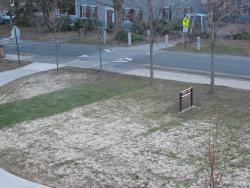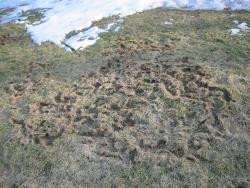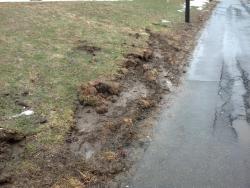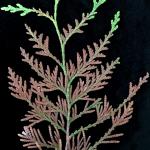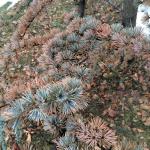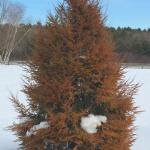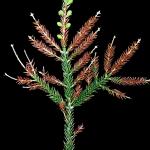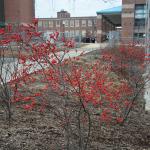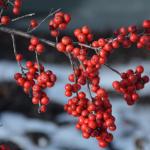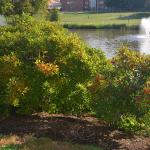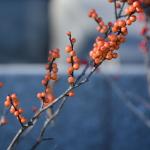A monthly e-newsletter from UMass Extension, published March to October, for home gardeners.
To read the articles in each section of the newsletter, click on the section headings below to expand the content:
Tips of the Month
March is the Month to…..
- Celebrate the arrival of spring! Monday March 20th is the first day of spring. Attending the Boston Flower Show would be a great way to celebrate. This year the show is March 22-26th and the theme is “Superheroes of the Garden”. If you can’t attend the flower show, consider a seminar or other horticulture related event to pick up some new tips and tricks (see our Mass Aggie Seminars at UMassGarden.org). Or head out to a sugar shack to enjoy some fresh maple syrup - Massachusetts Maple Weekend is March 19-20! Pick up an ornamental Oxalis (Shamrock) to celebrate St. Patrick’s Day.
- Be on the lookout for winter damage. Check for frost heaving which may have disrupted plant roots. If a problem is found, replant if the soil is not frozen or cover with soil and/or mulch until replanting is possible. Also repair any patio or walkway pavers that have been disturbed. Pay attention to where de-icing salt laden snow melt drains in your yard or flower beds. If there is not sufficient rainfall in the spring, these areas will need to be leached with water to avoid plant damage due to high salt concentrations in the soil.
- Force spring to come early! Prune branches of forsythia, crabapple, quince, crabapple, or pussy willow for forcing indoors. Remember to consider plant form when selecting branches and prune accordingly. Use sharp pruners and cut branches at least 12” long. Choose branches with many flower buds. It is best to cut branches on a sunny afternoon or when temperatures are above freezing. Keep branches in a bucket of water in a cool area (60 to 65 degrees F) in a humid area in indirect light until flowering begins.
- Start planning your garden. March is the time to start seeds indoors. The beginning of the month is the right time for onions and leeks. The middle of the month is right for broccoli and cabbage, and the end of the month is right for tomatoes and peppers.
- To prune or to not prune. Many trees and shrubs are good to prune in later winter/early spring. Remember to NOT prune spring flowering shrubs such as forsythia and lilacs at this time. It is also a good time to prune any dead or damaged branches from winter. March is also a good time to prune fruit trees such as apple, peach, and pear. Don’t prune maple or birch trees, which “bleed” when pruned in late winter/early spring – wait to prune these trees until after leaves are fully expanded.
- Check on your garden tools and equipment. Did you break your rake last fall? Now is a great time to get a replacement before spring clean-up begins. Plan on sharpening blades or replacing tools before the season really starts going. Change the mower oil. Get new garden gloves or start looking for new flower pots.
- Late winter/early spring cleanup can start. Pick up fallen branches and pine or spruce cones. Cut back ornamental grasses to around 2-3”. Cut back any perennials that weren’t cleaned up last fall. As the weather warms, clean up beds, removing fallen leaves and dead foliage - this will help to avoid disease issues. Be on the lookout for early spring bulbs! Clean out birdhouses to get ready for new visitors.
- Contact your local landscaper regarding any jobs you don’t want to do yourself. Call them early before their list grows.
- Watch for signs of drought injury from last year. Although the severity of drought has slowly been reducing over the fall and winter, much of the state is still considered to be under moderate to severe drought. Drought injury may not be apparent on some plants until this year. Possible drought injury symptoms that may arise this spring include: fewer and/or smaller leaves, shorter branches, dieback, reduced flowers and/or fruit set, browning of evergreen leaves and needles, and loss of branches. It is important to be patient as plants recover in the coming year.
Mandy Bayer, Extension Assistant Professor of Sustainable Landscape Horticulture, University of Massachusetts Amherst
Timely Topics
Early Spring Lawn Headaches
Here in New England, we tend to get a little bit of everything as far as the weather is concerned. While some enjoy, or at least don’t mind, the cold and snow that winter often brings, relatively few of us can deny occasionallygazing out the window on a winter’s day and daydreaming about warmth, fresh cut grass, and flowers in bloom.
At this time of year, on the verge of the transition from winter to spring, it will soon be time to transfer those thoughts into action. This is because some focused effort is frequently required to leave winter behind and produce a lawn that will be attractive and healthy throughout the coming growing season.
Here is the rundown on some headaches to watch for when the snow finally melts for good:
General winter injury – Turfgrasses can be injured in several different ways when temperatures are cold. Mechanisms include direct low temperature kill, frost damage, desiccation by dry winter winds, and damage caused by extended ice cover. Myriad factors that have a bearing on the occurrence of winter injury include turfgrass species and cultivars present, the level of management intensity, the quality of the late season acclimation experienced by the grass plants, presence or lack of snow cover, whether or not the soil is frozen, winter temperature fluctuations, etc. For any given plant, recovery from winter injury is possible as long as the turfgrass crown (growing point) remains fully viable. Recovery will take longer if the entire shoot and root system has died back and the plant needs to "start from scratch". Repairs to damaged areas by seeding or overseeding may be needed if significant portions of the stand have been killed or if the speed of recovery does not meet expectations.
Snow molds – Snow molds are caused by fungi capable of infecting turf at low temperatures and under snow cover. The two most common snow molds in the Northeast region are Typhula blight (gray snow mold) and Microdochium patch (pink snow mold). Although snow molds are a typical sight in early spring, damage is frequently superficial, especially with the higher cut turf found on lawns and grounds. The potential for lasting damage is greater on low mown, intensively managed sites such as golf courses and premier athletic fields. Recovery can be encouraged by raking to relieve matted turf after the stand dries, followed by light fertilization. Overseeding may be warranted in severe instances. Preventive measures to reduce snow mold incidence include avoiding nitrogen fertilization later in the fall, mowing regularly until grass growth ceases in the fall, and reducing thatch levels.
Vole damage – After winters with prolonged snow cover, vole damage is typically widespread due to the protection from predators that snow provides. Although disruption caused by vole activity can be alarming at first, the injury caused by feeding and traffic normally involves only the turfgrass shoot and not the crown or root system. Relatively quick, complete recovery often follows raking and spring fertilization.
It is a given that all manner of winter debris will accumulate in areas such as roadsides, driveway and walkway margins, and anywhere else that piles of snow are deposited. These materials can negatively affect spring green-up and fill-in, soil characteristics, and overall turf appearance. Larger objects and smaller abrasives alike can damage maintenance equipment and dull mower blades. Hand (brooms, rakes, shovels) or power (blowers, sweepers) tools should be used to remove sand, gravel and other foreign items from affected areas as soon as possible after the site dries sufficiently to permit such work.
De-icing salt injury – De-icing salts often contact turf either through careless application or when carried along with snow and/or runoff water. If damage from de-icing salts is suspected, apply focused irrigation to the affected area as soon as the ground thaws in the spring. If runoff is a concern, use multiple cycling to gradually move salts out of the root zone. Repairs to damaged turf may be necessary in some cases.
Mechanical surface damage – Another tired spring ritual is the appearance of areas damaged by snow removal equipment or vehicle traffic. It seems that the longer the winter lasts, the more effectively we forget exactly where the pavement ends and the turf begins. In other instances, increasing amounts of snow as the winter progresses necessitates movement onto turf surfaces. In defense of weary snow plow operators everywhere, similar damage can be caused by natural frost heaving. The prescription in this case involves 3 R's: Rolling, Raking, and Re-seeding. In some cases, some additional topsoil may beneficial/required.
Jason D. Lanier, UMass Extension Turf Specialist
News for Gardeners
Common Pathogens of Rhododendron and Azalea (Rhododendron)
Rhododendron and azalea are landscape ornamentals prized for their striking early season flowers, dark green foliage, adaptation to a range of sites and cold hardiness in New England. Like many common landscape ornamentals, they suffer from numerous diseases that range from trivial to highly destructive. Regular scouting is critical to identifying problems before they become widespread. Rhododendron and azalea nearly always suffer some form of winter injury and now is a good time to assess overall plant health and plan for the upcoming season. Now that the snow is melted, carefully examine the base of shrubs to determine if bark-chewing rodents like meadow voles have inflicted any damage over this past winter.
Phytophthora (Fie-top-thor-a) species are capable of attacking roots, stems and foliage of susceptible plants. Phytophthora diseases that lead to serious dieback and death are more common on recently transplanted shrubs that have preexisting infections. Root rot often leads to a major reduction of fine roots and a cinnamon brown discoloration of the vascular tissue that can progress to the base of the main stem. Foliar blights most often appear as marginal browning and scattered blotches on interior portions of the foliage. Flooded soils promote the development and spread of Phytophthora species, so avoid overwatering and planting in clay soils with poor drainage. Phytophthora species are abundant in rivers, streams and ponds when water temperatures are above 55° F. Care should be taken if plants are irrigated from a natural source.
Several fungal pathogens cause spots, blotches and blights of rhododendron and azalea foliage. Chief among this group are Pestalotiopsis (Pesta-low-she-op-sis) and Phyllosticta (Fie-low-stick-ta). Both fungi are opportunistic pathogens that invade through wounds created by pruning, winter injury and insect feeding, among others. Their actions result in a range of symptoms that may cause little overall harm (e.g. scattered leaf spots) to significant injury that can be an important contributor to decline (e.g. foliar and shoot blights). Early in the growing season, identify and prune foliage that has been damaged by cold weather during the winter months. Foliage damaged by cold weather will appear pale green to yellow and curls tightly. As the growing season begins, these injured leaves will become desiccated. Prune dead and dying stems and remove them from the site. Preventative fungicide applications can be helpful at times if foliar pathogens have caused considerable leaf loss. Early season applications to protect newly developing foliage should be carried out on regular intervals depending on local weather. If leaf damage from insect pests, such as the black vine weevil or rhododendron lacebug, is abundant throughout the canopy, consider treatment options to reduce populations.
Leaf browning and stem dieback on rhododendron and azalea is often the result of infection by opportunistic stem cankering fungi. Stems and branches decline for many reasons, such as breakage during transplanting, natural senescence and winter injury, among others. Prune and discard all dead stems to eliminate the sources of entry. Preventative fungicide treatments are not always effective or warranted for stem cankering fungi if all blighted stems can be effectively pruned from the canopy. With regular maintenance, rhododendrons and azaleas can maintain a healthy appearance with only minor disease issues for many years.
Nicholas J. Brazee, Plant Pathologist, UMass Extension Plant Diagnostic Lab, UMass Amherst
Trouble Maker of the Month
Winter Injury to Coniferous Trees and Shrubs in the Landscape
Evergreen conifers in the landscape can suffer freeze injury during the winter months when they are exposed to subzero air temperatures along with strong winds. The record cold temperatures the northeast experienced over the Valentine’s Day weekend in 2016 is a good example of conditions capable of causing injury to landscape conifers. While most northern temperate conifers are adapted to withstand very cold temperatures, various stresses can affect cold hardiness. Conifers may become susceptible to freeze injury after drought, insect infestation or a disease outbreak disrupts their ability to properly acclimate to cold weather. Additionally, freeze injury can occur after a partial deacclimation of cold hardiness takes place due to above-average temperatures in late winter or early spring. Symptoms become visible in the spring when temperatures warm and appear as needle browning, premature needle shedding and stem/branch dieback. Conifers that are recently transplanted (especially eastern hemlock) and those planted in open settings exposed to harsh winds are more likely to suffer freeze injury during the dormant period. When freeze injury is identified, these killed plant parts should be pruned and removed to avoid colonization of the dead tissues by opportunistic insect pests and fungal pathogens.
Plant of the Month
llex verticillata, Winterberry
The bright red berries that give llex verticillata its common name of winterberry, provide a vibrant pop of color in the winter landscape. The species grows 6-10’ tall and wide with an upright spreading form. Flowers occur in June, although flowers are not showy. Winterberry are dioecious, meaning that there are both male and female plants. One male plant is needed for every 6-10 female plants to ensure good fertilization and berry set. Berries color in October and persist fall through winter.
An eastern North American native, I. verticillata’s is often found along streams, woodland edges, or in swamps in its natural habitat. Winterberry is a good choice for wet areas or along ponds and streams, in shrub borders, native gardens, bird gardens, or as a hedge. Plants do well in full sun to part shade with an acidic soil. Fall color is not always good but can be purple-red. Winterberry does not have any serious insect or disease issues.
Cultivars of interest include:
- ‘Afterglow’ - a more compact (3-6’) female cultivar with orange red berries
- ‘Jim Dandy’ - a male cultivar that serves as a pollinator for certain female cultivars such as ‘Red Sprite’ and ‘Afterglow’
- ‘Nana’ (Red Sprite) - a dwarf (2-3’) female cultivar with large red berries
- ‘Winter Red’ – 6-8’ female cultivar with good fruit set or bright red berries
- ‘Winter Gold’ – 5-8’ female cultivar with good fruit set of orange-yellow berries. Needs a late-blooming male pollinator
Mandy Bayer, Extension Assistant Professor of Sustainable Landscape Horticulture, University of Massachusetts Amherst
Upcoming Events
Each year, UMass Extension offers a workshop series for home gardeners and small scale farmers.
2017 Topics
- March 4 Home Orchard Pruning (focus on apples) - a Hands-on Workshop (Sherborn)
- March 11 Apple Tree Grafting - a Hands-on Workshop (Belchertown)
- March 18 Pruning Blueberries - a Hands-on Workshop (Bolton)
- March 25 Pruning Raspberries & Other Brambles - a Hands-on Workshop (Sharon)
- April 8 Home Orchard Establishment & Basics - a Hands-on Workshop (Sherborn)
- April 15 Edible Landscaping with Fruit (Amherst)
For complete details, cost, and to register, go to UMassGarden.org.
Additional Resources
Landscape Message - for detailed timely reports on growing conditions and pest activity
Home Lawn and Garden Resources
Find us on Facebook! https://www.facebook.com/UMassExtLandscape/
Follow us on Twitter for daily gardening tips and sunrise/sunset times. https://twitter.com/UMassGardenClip
Diagnostic Services
The UMass Extension Plant Diagnostic Lab provides, for a fee, woody plant and turf disease analysis, woody plant and turf insect identification, turfgrass identification, weed identification, and offers a report of pest management strategies that are research based, economically sound and environmentally appropriate for the situation. Accurate diagnosis for a turf or landscape problem can often eliminate or reduce the need for pesticide use. Sampling procedures, detailed submission instructions and a list of fees.
The UMass Soil and Plant Nutrient Testing Laboratory at the University of Massachusetts Amherst provides test results and recommendations that lead to the wise and economical use of soils and soil amendments. The Routine Soil Analysis fits the needs of most home gardeners. Sampling procedures plus the different tests offered and a list of fees.
Spread the Word!
Share this newsletter with a friend! New readers can subscribe to our Home Gardener E-Mail List.
